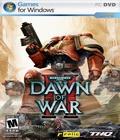Playing a console game is always a known quantity. No matter what the system, you know that setup never takes more than putting in the game and turning on the system. A minute or so later, you're there playing, controller in hand, and no matter where you are, you know that your experience is going to be the same as anyone else playing that game. With PC titles, however, it's not so cut-and-dry. PCs often have different hardware so gamers are forced to rely on listed specs to know if a game will run or simply laugh upon installation. Even minimum specs can be misleading, as marketing departments often stretch the truth a bit in the hope of making more sales.
Although we've heaped a lot of praise on both the single-player and multiplayer aspects of Dawn of War II, until recently we weren't allowed to play it on our own computers. Instead, we had to play on machines that accompanied the dev team on the visits. Though the game was fun, we were left wondering, "How is this going to play on an average system?"
The answer to that question came last month, when THQ and Relic released the Dawn of War II multiplayer beta on Steam. Containing the core multiplayer element of Dawn of War II, the beta allowed us to take a look at how the game performed on low-end hardware as well as uber-powered gaming machines.
We were pleasantly surprised by the results, finding that not only did the beta run on a minimum spec machine, but it ran well. Sure, it didn't run in a super-high resolution with all of the effects turned up to high, but it was more than playable at 1024x768 with basic effects enabled. We played a few rounds against the AI before heading online to check out the competition.
Playing online was a little different than going toe-to-toe with another player in the same room, though that mostly had to do with communication differences. Not everyone who plays online has a headset enabled, and not everyone notices text messages scrolling by the chat window on-screen. Otherwise, everything was there, and all features were enabled.
Our only real complaint with the online beta had to do with the matchmaking system, or rather the inability of the average player to comprehend how it all works. More often than not, we would join a pickup game only to be kicked out because the host was "waiting for a friend." Given the fact that Dawn of War II allows you to reserve specific slots for friends as well as make the entire game invite-only (so random folks like us wouldn't be able to join), it was a bit annoying to find that a large number of players weren't using the tools they were given. Alas, there's no accounting for general stupidity. Here's hoping that once more players jump into the mix, starting a game will be a more expedient affair.
The beta may be limited to competitive multiplayer, but Dawn of War II also features co-op multiplayer for the main campaign. In between rounds of online competition, we took a break to meet with the developers from Relic and see what co-op was all about.
Starting a co-op campaign is just like starting a single-player campaign. In fact, everything is the same, save for how you control your squads. Playing solo, you control up to four squads at a time. In co-op, each player controls two out of the four squads. Because co-op is based on the single-player campaign, there is no squad cloning. If one player has control of a specific squad, the second can't take control unless the first player releases the squad.
Assuming you and your co-op partner have good communication, playing co-op is slightly easier than attacking a solo mission simply because you have two sets of eyes and ears on the field. Coordinating a two-pronged attack can wreak havoc on an enemy encampment in no time. Of course, the flip side is true as well. If you don't talk to your partner and one player wanders off solo, your chances of being overpowered by the enemy increase greatly.
Upgrading and equipping units happens between missions, just as it does in the solo campaign. Items aren't doubled simply because there are two players, so if there's a goody that you both want to use, it's time to figure out which squad needs it the most.
Unfortunately, the co-op campaign only supports one save file and that is on the host computer. This allows for drop in/drop out play on the part of the co-op partner, but it does not allow you to carry over any of your experience or items into a friend's game. If the co-op guest drops connection to the host, the host simply takes control of all four squads until the guest reconnects. If the host drops connection, though, the guest is booted out of the game and back to the menu screen. It's a bit harsh when it happens.
Having seen all the different components of Dawn of War II, we're optimistic about the quality of the final game. As long as there are no last-minute surprises, Dawn of War II should rule the RTS roost, at least until Starcraft II steps up as a challenger.
More articles about Warhammer 40,000: Dawn of War II











 Warhammer 40,000: Dawn of War II is set in the grim, war-ravaged world of Games Workshop's Warhammer 40k universe -- a dark, futuristic, science-fiction setting where armies of technologically advanced warriors, fighting machines and hordes of implacable aliens wage constant war.
Warhammer 40,000: Dawn of War II is set in the grim, war-ravaged world of Games Workshop's Warhammer 40k universe -- a dark, futuristic, science-fiction setting where armies of technologically advanced warriors, fighting machines and hordes of implacable aliens wage constant war.





























